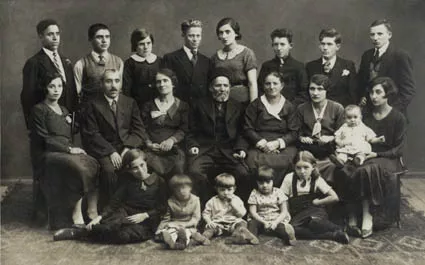The family of Sabat Moshe Pilosof
This is a photo taken in Dupnitsa on Yom Kippur 1934. In this picture my paternal grandparents’ families can be seen.
In the first row first from left is my sister Roza Levi (nee Pilosof), then comes Lili, Aunt Regina Mordoch’s child and then the other Lili, the child of uncle Mordo Pilosof, and then Zelma, my father's sister.
Sitting from left to right in the middle row are: Sara, my father's sister-in-law: wife of uncle Mordo Pilosof, then comes my father Leon Pilosof, my mother Tamara Pilosof (nee Konfort), my grandfather Sabat Pilosof, my grandmother Lea Pilosof (nee Astrug), Regina Mordoch - my father's sister, Buka Pilosof, my father's sister-in-law and wife of uncle Mois Pilosof with their child Sabat.
In the third row standing first from left is uncle Mordo Pilosof - my father's brother. I am next to him, then comes my sister Lizka Yakova (nee Pilosof), Buko Davidov with his wife Ester - my father's sister, uncle Solomon Pilosof - my father's brother, Baruh Mordoch - Regina Mordoch's husband and Uncle Mois Pilosof, my father's brother.
My grandfather disliked having his picture taken. He had only this picture with some of his children taken. My uncles made every possible effort to persuade him to go to the photo studio. They said they even gave him money, so that he would go there.
My grandfather was born in Dupnitsa. In his youth he was an associate in a shop in the village of Cherven Briag, which is eight kilometers from Dupnitsa. He worked there for many years. I remember how he regularly sent us milk and fresh cheese, made there. When they couldn't sell the cheese they used to send it to us. Every Saturday my grandfather returned to Dupnitsa. It seems that there weren't many work places in Dupnitsa, and therefore he worked in other places. When he finally returned to Dupnitsa, as an elderly man, he started to help in a shop in Dupnitsa.
My paternal grandfather's house was in the Jewish neighborhood, which was situated in the area of the Jerman River, which crosses the town. There were various houses there. Both the rich and poor Jews lived there. Most of the houses were one-floor ones with adjoined yards. My grandfather shared a yard with three of his brothers. The houses were either detached from one another, or opposite each other. One of my grandfather's brothers lived next to him, and their sister lived on the opposite side of the street.












